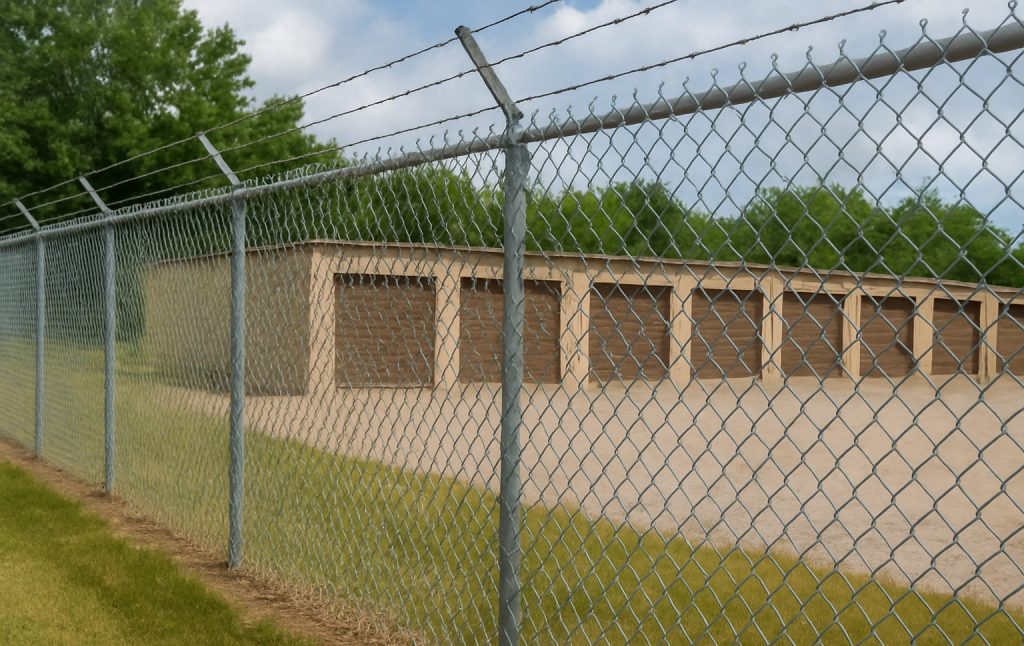Chain Link Fences for Storage Facilities are among the most reliable and cost-effective solutions for protecting valuable assets. They offer visibility, strength, and adaptability, making them an essential choice for businesses that manage large outdoor spaces. This post explores their advantages, regulatory considerations, and alternative materials that also meet compliance requirements.
Why Security Is Critical for Storage Facilities
Storage areas face unique challenges: protecting against theft, deterring trespassers, and ensuring liability coverage. A strong perimeter fence not only safeguards goods but also reassures clients that their property is secure. In most cases, local codes demand higher standards for storage facilities compared to residential properties.
Advantages of Chain Link Fencing
Chain link systems remain the most practical choice for many reasons:
Visibility: The mesh structure allows for unobstructed monitoring by staff and cameras.
Durability: Galvanized or coated options resist corrosion, extending lifespan.
Affordability: Ideal for covering large areas without exceeding budgets.
Flexibility: Can be customized with barbed wire, razor ribbon, or privacy slats.
These features make chain link the go-to option for most storage businesses.
Regulatory Requirements
Local regulations shape how storage facility fences must be installed:
Height restrictions: Many municipalities require fences of at least 6–8 feet in commercial zones.
Permits: Projects usually require city approval and site plans before construction begins.
Safety codes: Visibility at driveways and intersections is often mandatory.
By following these rules, facility owners avoid delays, fines, and costly redesigns.
Exploring Alternative Fence Options
While chain link dominates in storage, other materials can be better suited in certain cases:
Steel Fence: Strong and resistant, ideal for heavy-duty industrial facilities.
Vinyl Fence: A low-maintenance option that adds privacy when needed.
Ornamental iron fence: Frequently chosen in districts that require durable barriers with an elegant design, especially in areas where zoning rules demand compliance with architectural or historic styles.
Each option meets specific requirements while maintaining regulatory approval.
Enhancing Security with Add-Ons
Storage facilities often go beyond standard fencing by adding:
Barbed wire or razor ribbon to deter intruders.
Privacy slats to conceal valuable equipment or goods.
Electronic access gates integrated with cameras and alarms.
These additions reinforce the fence’s role as a comprehensive security system.
Cost Considerations
Chain link is cost-effective, but managers must also account for long-term upkeep. Regular maintenance prevents corrosion and ensures fences remain strong. In cases where damage occurs, scheduling chain link fence repair Chicago services helps businesses extend the life of their investment without needing full replacements.
Proper budgeting for permits, inspections, and periodic upgrades like lighting or access control ensures compliance and avoids unexpected expenses.
Local Expertise and Compliance
Working with professionals who know municipal codes is essential. Contractors familiar with storage facility requirements help:
Navigate zoning and permitting processes.
Install fences that meet ADA and safety standards.
Deliver on time without compliance issues.
Experienced teams specializing in commercial fence installation Chicago ensure that projects remain both secure and lawful.
External Resource for Guidance
For non-competitive, authoritative reference, consult OSHA Workplace Outdoor Safety Standards, which include perimeter security guidelines:
This resource strengthens compliance efforts and builds trust in your facility’s safety measures.
Conclusion
Storage facilities require fencing that balances affordability, compliance, and strength. Chain link remains the leading option for visibility and cost-efficiency, but alternatives like steel, vinyl, and ornamental iron may be necessary in specific districts. By planning around local regulations, budgeting effectively, and consulting professionals, businesses ensure their fencing projects achieve maximum security. Ultimately, aligning design and compliance builds customer confidence and long-term protection for valuable assets.

